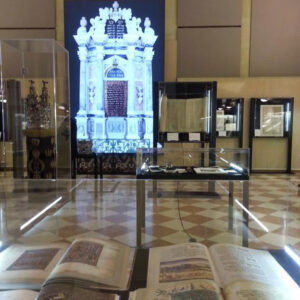A museum to meet and express yourself
 “The greatest heritage of the Jewish Community of Padua does not consist of its objects, albeit beautiful and highly valuable. It consists of the people who lived there”. This is the idea behind the Museum of Jewish Padua, inaugurated in June 2015, as emerges from the reflections of the then president Davide Romanin Jacur. A place of life and tales in the spaces of the ancient German synagogue, founded between 1522 and 1525 and active until May 1943, when it was set on fire by a local Fascist squadron. Amongst the numerous objects in the collection, the museum exhibits traditional artifacts for family use, such as candlesticks, spice holders, Pesach dishes, and objects related to synagogue rituals, amongst which a parochet of Mamluk origin from the 15th century, fine fabrics and Sefer Torah stand out. The multimedia experience is also suggestive. It was made possible by two audiovisual supports available to visitors. A short and engaging documentary offers a historical overview of the Paduan community and its places: from the synagogues to the ancient cemeteries. At the center of a video-installation (“Generazione va, Generazione viene”, literally “Generation goes, Generation comes”) by director Denis Brotto stand the women and men who have made it a Jewish center of great vitality. In the installation some illustrious personalities come to life to tell their own story, ideally addressing the public. That is, “to all those who are called to receive the witness and pass it on to others”. These are Rabbis such as Judah Mintz, Meir Katzenellenbogen, Isaac Abravanel, Samuel David Luzzatto (SHaDaL), Moshè Chayyim Luzzatto (RaMHaL), Moshè David Valle, but also “civilian” personalities such as Senator Leone Romanin Jacur, lawyer and mayor Giacomo Levi Civita, economist Leone Wollemborg and Vittorio Polacco, also a senator, who was a member of the Accademia dei Lincei, as well. Glorious figures of a past that has not stopped talking to us. The museum itself, as the chief rabbi Adolfo Locci recalled, was born not only with the desire to “show a story that makes us proud”, but also “the vitality and subsistence of a community that exists, is alive, and is projected towards the future”. He proved this right in the spaces of the museum, where for the first time in 77 years, last Yom Kippur, the synagogue returned for a few hours to its ancient use: a place of prayer. A touching opportunity.
“The greatest heritage of the Jewish Community of Padua does not consist of its objects, albeit beautiful and highly valuable. It consists of the people who lived there”. This is the idea behind the Museum of Jewish Padua, inaugurated in June 2015, as emerges from the reflections of the then president Davide Romanin Jacur. A place of life and tales in the spaces of the ancient German synagogue, founded between 1522 and 1525 and active until May 1943, when it was set on fire by a local Fascist squadron. Amongst the numerous objects in the collection, the museum exhibits traditional artifacts for family use, such as candlesticks, spice holders, Pesach dishes, and objects related to synagogue rituals, amongst which a parochet of Mamluk origin from the 15th century, fine fabrics and Sefer Torah stand out. The multimedia experience is also suggestive. It was made possible by two audiovisual supports available to visitors. A short and engaging documentary offers a historical overview of the Paduan community and its places: from the synagogues to the ancient cemeteries. At the center of a video-installation (“Generazione va, Generazione viene”, literally “Generation goes, Generation comes”) by director Denis Brotto stand the women and men who have made it a Jewish center of great vitality. In the installation some illustrious personalities come to life to tell their own story, ideally addressing the public. That is, “to all those who are called to receive the witness and pass it on to others”. These are Rabbis such as Judah Mintz, Meir Katzenellenbogen, Isaac Abravanel, Samuel David Luzzatto (SHaDaL), Moshè Chayyim Luzzatto (RaMHaL), Moshè David Valle, but also “civilian” personalities such as Senator Leone Romanin Jacur, lawyer and mayor Giacomo Levi Civita, economist Leone Wollemborg and Vittorio Polacco, also a senator, who was a member of the Accademia dei Lincei, as well. Glorious figures of a past that has not stopped talking to us. The museum itself, as the chief rabbi Adolfo Locci recalled, was born not only with the desire to “show a story that makes us proud”, but also “the vitality and subsistence of a community that exists, is alive, and is projected towards the future”. He proved this right in the spaces of the museum, where for the first time in 77 years, last Yom Kippur, the synagogue returned for a few hours to its ancient use: a place of prayer. A touching opportunity.
Translated by Gianluca Pace, student at the Advanced School for Interpreters and Translators of the University of Trieste, intern at the newspaper office of the Union of the Italian Jewish Communities.
Revised by Oyebuchi Lucia Leonard, student at the University of Trieste, intern at the newspaper office of the Union of the Italian Jewish Communities.
